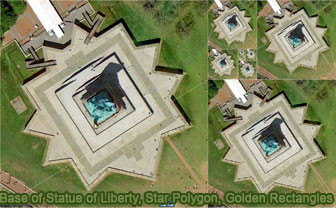Uncover the Hidden Geometry of the Statue of Liberty:
Experience the Hendecagram, an 11-Pointed Star Polygon, through our Stunning
HTML5 Animation!
Eleven sides strong
Hendecagram at the base
Liberty stands tall
Eleven points of light
A star-shaped base for freedom
A beacon to all
A logarithmic spiral, known as the golden spiral, is formed by successive golden rectangles that divide a larger golden rectangle into squares.
The Base of the Statue of Liberty
The base of the Statue of Liberty is indeed a hendecagram, which is a star polygon with 11 vertices. A star polygon is a geometric figure that is formed by connecting the points of a regular polygon in a specific pattern, resulting in a series of non-intersecting line segments that form a star-like shape.
The hendecagram has 11 vertices, or points where the line segments of the polygon meet. The Statue of Liberty's base is shaped like a regular hendecagram, with each of the 11 vertices located at the bottom of a triangular-shaped recess in the pedestal. The recesses are designed to emphasize the height and graceful lines of the statue, and they also serve as a practical means of support for the massive pedestal.
In addition to its functional purpose, the hendecagram is also a symbol of the Statue of Liberty's message of unity and inclusiveness. The number 11 is considered a "master number" in numerology, and is associated with creativity, intuition, and spiritual growth. The hendecagram's 11 points can be seen as representing the 11 million immigrants who entered the United States through Ellis Island, which lies just a short distance from the statue.Fort Wood's star-shaped walls became the base of the Statue of Liberty. In geometry, a hendecagram is a star polygon that has eleven vertices.
Golden rectangle
A golden rectangle
is a rectangle whose side lengths are in the golden ratio,
one-to-phi, that is, approximately 1:1.618. A distinctive
feature of this shape is that when a square section is
removed, the remainder is another golden rectangle, that is,
with the same proportions as the first. Square removal can
be repeated infinitely, which leads to an approximation of
the golden or Fibonacci spiral.
Droste Effect
The Droste effect is a specific kind of recursive picture, one that in heraldry is termed mise en abyme. An image exhibiting the Droste effect depicts a smaller version of itself in a place where a similar picture would realistically be expected to appear. This smaller version then depicts an even smaller version of itself in the same place, and so on. Only in theory could this go on forever; practically, it continues only as long as the resolution of the picture allows, which is relatively short, since each iteration geometrically reduces the picture's size. It is a visual example of a strange loop, a self-referential system of instancing which is the cornerstone of fractal geometry.
Source:
Wikipedia,
Droste Effect.

|